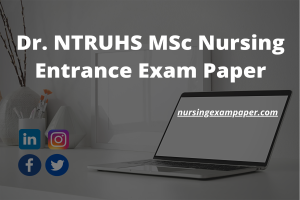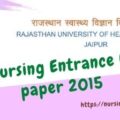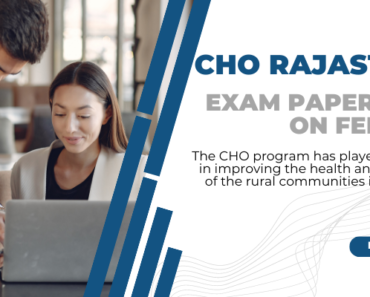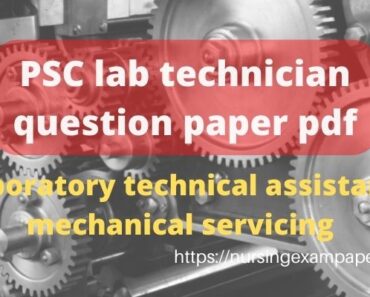Admission in the Msc Nursing is purely based on the score of students in the nursing entrance exam. The separate entrance examination for B.Sc & M.Sc nursing is conducted every year. Get complete information including exam dates, exam pattern, syllabus, application form, eligibility criteria, etc. M Sc Nursing Entrance 2019 Test Previous Question Paper and Answers Dr.NTRUHS- Dr. Nandhamuri Tharaka Ramarao University of Health Sciences Vijayawada Andhra Pradesh M Sc Nursing Entrance Exam 2016 Previous Test Paper
1. Which method is used to make the learners study in detail about specific things person or place?
A. Case study method
B. Project method
C. Field trip method
D. Laboratory method
2. Which method is used to develop scientific inquiry among learners?
A. Project
B. Case study
C. Problem-solving
D. Simulation
3. In palpating the client’s abdomen, which of the following is the best position for the client to assume?
A. Side-lying
B. Supine
C. Lithotomy
D. Dorsal recumbent
4. A type of educational assessment which is generally carried out throughout a
course or project is: ^
A. Summative assessment
B. Formative assessment
C. Criterion-referenced assessment
D. Normal assessment
5. Considered as the safest and most non-invasive method of temperature taking:
A. Rectal
B. Tympanic
C. Axillary
D. Oral
6. What is teaching through the deductive method?
A. From general to specific
B. From specific to general
C. From macro to micro
D. From easy to difficulty
7. The ability of an instrument to achieve consistently the same result is:
A. Validity of instrument
B. Reliability of the instrument li
C. Understandability of the instrument
D. The perfectionism of the instrument
8. Inputting sterile gloves, Which should be gloved first?
A. The dominant hand
B. The nondominant hand
C. The left hand
D. No specific order, it’s up to the nurse for her own convenience
9. The suggested time per hand on handwashing using the time method is:
A. 5 to 10 seconds each hand
B. 10 to 15 seconds each hand U
C. 15 to 30 seconds each hand
D. 30 to 60 seconds each hand
10. Mental processing of the message and understanding the sender’s message is
A. Decode
B. Encode
C. Feedback
D. Imagination
11. Which of the following method where subject matter It has broken down Into small frames and arranged sequentially?
A. Simulation
B. Programmed instructions
C. lecture
D. Demonstration
12. Scientific management theory was developed by:
A. Max weber
B. Frederick Taylor
C. Adam smith
D. Renlsllkert
13. Collaboration In providing care to a group of patients by a group of nursing personnel under the direction of a professional nurse Is:
A. Case method.
B. Primary method
C. Team methods
D. Modular method
14. Which of the following Involves all the assessment methods that occur after the patient has been discharged:
A. Concurrent evaluation
B. Auditing
C. Retrospective evaluation
D. Quality assurance
MSc nursing entrance exam model question papers, aiims MSc nursing entrance exam 2018, aiims MSc nursing entrance exam syllabus Msc nursing entrance question paper 2011, MSC nursing entrance questions and answers, MSc nursing entrance exam 2015
15. The four main concepts common to nursing that appear in each of the current conceptual models are:
A. Person, nursing, environment, medicine
B. Person, nutrition, nursing, support systems
C. Person, health, environment, nursing
D. Environment, Most, Person, Hygiene
16. The phrase used in nursing diagnosis which is linked to the etiology is:
A. “as manifested by”
B. “related to”
C. “evidenced by”
D. “due to”
17. The theorist who advocated that health Is the ability to maintain dynamic equilibrium is:
A. Bernard
B. Selye
C. Cannon
D. Rogers
18. The third period of Infectious processes characterized by the development of specific signs and symptoms:
A. fitness period
B. Incubation period
C. Prodromal period
D. Convalescent period
MSc. Nursing Entrance Exam
19. Self-monitoring of blood glucose for diabetic clients is on what level of
prevention?
A. Primary
B. Secondary
C. Tertiary
D. None of the above
20. Comprehensive, individualized care provided by the same nurse throughout
the period of care refers to :
A. Team nursing
B. Primary nursing
C. Home Health Nursing
D. Critical care nursing
21. Which substance has the most significant effect on sodium regulation?
A. Renin level
B. Aldosterone level
C. GFR
D. Serum pH
22. The nurse should realize the angina pectoris is e sign of:
A. Mitral Insufficiency
B. Myocardial Infarction
C. Myocardial ischemia
D. Coronary thrombosis
23. Among the following statements, should be given the HIGHEST priority?
A. A client with extreme pain
B. The client with blood pressure 60/40 mmHg
C. A client with temperature 40-degree celsius
D. Client with cyanosis
24. Which of the following is an OBJECTIVE data?
A. Blue nails
B. Dizziness
C. Chest pain
D. Anxiety
25. Which of the following statement Is TRUE about a pulse?
A. Males have a higher pulse rate than females after puberty
B. Young person has higher pulse than older persons
C. In the lying position, pulse rate is higher
D. Pulse rate decreases during exercises
26. A type of heat loss that occurs when the heat is dissipated by air current:
A. Convection
B. Conduction
C. Radiation
D. Evaporation
27. Drug of choice In OCD:
A. Diazepam
B. Haloperidol
C. TrihexiphenidylCI
D. Fluoxetine
28. Long-acting antipsychotic:
A. Haldol decanoate
B. Chlorpromazine
C. Olanzapine
D. Clozapine
29. When teaching Mr. layag, who has been placed on a high- unsaturated fatty acid diet, the nurse should stress the Importance of increasing the Intake of:
A. Enriched whole milk
B. Red meats, such as beef
C. Vegetables and whole grains
D. Liver and other glandular organ meals
Uttarakhand state government MSc nursing entrance exam paper
30. Which of the conditions are early symptoms commonly seen in myasthenia gravies?
A. Dysphagia
B. Fatigue Improving at the end of the day
C. Ptosis
D. Respiratory distress
31. Which of the following statements best describes the Parkinson’s Disease?
A. Loss of myelin sheath surrounding peripheral nerves
B. Degeneration of the substantia nigra; depleting dopamine
C. Bleeding into the brain stem, resulting in meter dysfunction
D. An autoimmune disorder that destroys acetylcholine receptors
32. Schizophrenia characterized by a phase of stupor or excitement:
A. Simple Schizophrenia
B. Paranoid schizophrenia
C. Hebephrenic schizophrenia
D. Catatonic Schizophrenia
33. Leprosy is also called as:
A. Hartmann’s disease
B. Hansen’s disease
C. Harry’s disease
D. Humprey’s disease
34. The most frequent causes of death among clients with AIDS are opportunistic diseases. Which of the following opportunistic infections?
A. Respiratory candidiasis
B. Infectious mononucleosis
C. Rubella
D. Encephalitis
35. Anti therapeutic communication technique:
A. Silence
B. Questioning
C. Listening
D. Advising
36. Which of the following activities would be most appropriate for a client who has bipolar disorder with aggressive behavior?
A. Badminton
B. Writing
C. Chess
D. Basketball
37. In a client with alcohol abuse, Korsakoffs psychosis may be caused due to deficiency of:
A. Vitamin A
B. Niacin
C. Thiamine
D. Vitamin C
38. The technique of exposing a client to fear-producing sensation in a gradual manner is called:
A. Biofeedback
B. Imaging
C. Relaxation technique
D. Systematic desensitization
39. Floating tip of the iceberg represents:
A. Clinical cases
B. Apparent cases
C. Latent cases
D. Undiagnosed cases
40. The disease notifiable to the WHO under the International Regulation Act is all except:
A. Cholera
B. Plague
C. Yellow fever
D. Diphtheria
41. Quarantine is related to:
A. Minimum incubation period
B. Maximum incubation period
C. Serial interval
D. Generation time
42. Which of the following is not spread by Aedes mosquito:
A. Dengue fever
B. Chikungunya
C. Japanese encephalitis
D. Yellow fever
43. The first time interval between the invasion by an infectious agent and appearance of the first signs and symptoms of the disease:
A. Latent period
B. Quarantine
C. Incubation period
D. Termination period
44. The study which proceed from effect to cause is:
A. Cohort
B. Case-control
C. Ecological
D. Experimental
45. A sub-center in a hilly area caters to a population of:
A. 1000
B. 2000
C. 3000
D. 5000
46. The common cause of mid-trimester abortion is:
A. Infection
B. Cervical incompetence
C. Congenital anomalies in the foetus
D. Hormonal imbalance in mother
47. The relationship of the long axis of the fetus to the long axis of the uterus is:
A. Attitude
B. Presentation
C. Lie
D. Denominator
48. In a gynaecoid pelvis widest diameter of inlet is:
A. Antero-posterior diameter
B. Transverse diameter
C. Oblique diameter
D. All diameters are equal
49. Increases level of HCG hormone is an indication of:
A. Placenta praevia
B. Hydatidiform mole
C. Polyhydramnios
D. PIH
50. The micro-organism which causes vaginitis commonly is:
A. Candida albicans
B. Streptococci
C. E.coli
D. Lactobacillus
MSc nursing entrance exam
MSc nursing entrance exam syllabus, MSc nursing question bank, MSc nursing entrance exam books pdf free download, MSc nursing entrance exam 2016
51. The best method of delivery system to provide care for comatose patients is:
A. Case method
B. Function method
C. Case and function method
D. Function and team method
52. Which of the following means translating the message into verbal and nonverbal symbols to communicate the receiver :
A. Encoding
B. Decoding
C. Channel
D. Feedback
53. Which of the following styles best when the followers are self-directed,
experts and are matured, individuals?
A. Democratic
B. Authoritarian
C. Laissez-faire
D. Bureaucratic
54. Which of the following behaviors is manifested by the leader who uses path-goal theory?
A. Recognizes staff for going beyond expectations by giving them citations
B. Challenges the staff to take individual accountability for their own active
C. Admonishes staff for being laggards
D. Reminds staff about the sanctions for non-performance
55. The manager stresses the need for all the employees to follow orders and instructions from him and not from anyone else. Which of the following principles does he refer to?
A. Scalar chain
B. Discipline
C. Unity of command
D. Order
56. Ramdas orients his staff on the patterns of reporting relationships in the
organization. Which of the following principles refer to this?
A. Span of control
B. Hierarchy
C. Esprit de corps
D. Unity of direction
57. Quality council of India sponsored accreditation system for hospitals and health care providers is:
A. NABH
B. Joint commission international
C. BIS
D. NABET
58. The manager asserts the importance of promoting a positive organizational culture in their unit. Which of the following behaviors indicate that this is attained by the group?
A. Proactive and caring with one another
B. Competitive and perfectionist
C. Powerful and uncomplaining
D. Obedient and uncomplaining
59. Finding the most cost-effective way of doing a project:
A. Network analysis
B. System analysis
C. Cost analysis
D. Field analysis
60. In the value: 80,81,82,90,100,102 what is the mode?
A. 80
B. 82
C. 90
D. 85
61. In which of the following sampling technique every member of the population has an equal chance of being selected as a subject?
A. Simple random
B. Purposive
C. Convenient
D. Quota
62. One group pre-test-post test design is a type of:
A. True experimental
B. Pre-experimental
C. Descriptive design
D. Comparative design
63. Which of the following is a positive sign of pregnancy?
A. Amenorrhoea
B. Urinary frequency
C. Breast tenderness
D. The fetus is seen on ultrasound
64. Extra calorie intake recommended for lactating mothers is:
A. 300 Kcal/day
B. 400 Kcal/day
C. 550 Kcal/day
D. 800 Kcal/day
65. Intake of which of the following can prevent neural tube defects?
A. Folic acid
B. Thiamine
C. Niacin
D. Riboflavin
66. Which of the following is an abnormal finding in a normal pregnancy?
A. Fundus at umbilicus at 36 weeks
B. Fundus at xiphisternum at 36 weeks
C. Mother felt quickening at 18 weeks
D. Fundal height increase 4 cm per week after 24 weeks
67. Development of specific antibody in an Rh-positive baby is:
A. Antiimmunization
B. Isoimmunization
C. Iso metricity
D. Antigenicity
68. Which of the following is a measurement of central tendency?
A. Mean
B. Standard deviation
C. Range
D. Correlation coefficient
69. The Hypotheses express the absence of relationships:
A. Directional
B. Null
C. Reverse
D. Non-directional
70. What is the effect of hypothyroidism on BMR?
A. BMR Increases
B. BMR Decreases
C. BMR unchanged
D. BMR initially increases but later decreases
Uttarakhand state government MSc nursing entrance exam paper
71. Milk is rich in all except:
A. Vitamin A
B. Calcium
C. Iron
D. Vitamin E
72. The nurse is caring for a client with a diagnosis of chronic gastritis. The nurse knows that this client is at risk for which of the following vitamin deficiencies?
A. Vitamin A
B. Vitamin B12
C. Vitamin C
D. Vitamin E
73. One gram fat provides how many calories?
A. 3 calories
B. 4 calories
C. 6 calories
D. 9 calories
74. Which of the following is a deficiency disease of vitamin A?
A. Pellagra
B. Scurvy
C. Pernicious Anemia
D. Night Blindness
75. The process of selecting a portion of the population to represent the entire population.
A. Subset
B. Delimitation
C. Sampling
D. Categorizing
76. A nurse is assisting a physician with the removal of a chest tube. The nurse most appropriately instructs the client to:
A. Stay very still
B. Inhale and exhale quickly
C. Exhale slowly
D. Perform Valsalva’s maneuver
77. A parametric statistical test for analyzing the difference between two means is called:
A. ANOVA
B. t-test
C. Standard deviation
D. Chi-square
78. You are interested to study the effects of medication and tactile stimulation on the pain experienced by the cancer patients. What type of variable is pain?
A. Dependent
B. X variable
C. Independent
D. Interdependent
79. Which of the following studies is based on qualitative research?
A. A study examining the client’s reaction to stress after open-heart surgery
B. A study measuring weight loss/gain in clients with cancer
C. A study examining oxygen levels after endotracheal suctioning
D. A study measuring differences in blood pressure before, during and after a procedure
80. Which of the following design is best suited for a study for the development of a new tool to measure intelligence by creating a 100 item questionnaire?
A. Historical
B. Methodological
C. Survey
D. Case study
81. A client with paranoid schizophrenia is expected to present with:
A. Anger, auditory hallucination, persecutory delusion
B. Abnormal motor activity, frequent posturing, autism
C. Flat affect, anhedonia, alogia
D. Silly behavior, poor personal hygiene, incoherent speech
82. SSRI’s may cause:
A. Gastrointestinal upset
B. Hypertensive crisis
C. Neuromuscular effects
D. Urinary retention
83. A nurse is caring for a client with type I diabetes mellitus Which client
the complaint would alert the nurse to the presence of a possible hypoglycemic reaction?
A. Hot, dry skin
B. Muscle cramps
C. Anorexia
D. Tremors
84. A client is diagnosed with pheochromocytoma, the nurse understands the pheochromocytoma is a condition that:
A. Causes profound hypotension
B. It causes the release of excessive amounts of catechol-amines.
C. Is not curable and is treated symptomatically
D. Is manifested by severe hypoglycemia
85. A nurse develops a plan of care for a client with hyperthyroidism and includes which of the following in the plan?
A. Provide small meals
B. Provide extra blanket
C. Provide a high-fiber diet
D. Provide a restful environment
86. The nurse inspects the oral cavity of a client with candidiasis. Which of the following would the nurse expect to note?
A. The presence of numerous small red pinpoint lesions
B. The presence of blisters
C. The presence of white patches
D. The presence of purple-colored patches
87. Pertussis is also known as:
A. TB
B. Pneumonia
C. Whooping cough
D. Measles
88. Discharge teaching for a child with celiac disease would include instructions about avoiding which of the following:
A. Rice
B. Milk
C. Wheat
D. Meat
89. The neuroleptic malignant syndrome can occur due to the side effect of:
A. Anti-anxiety
B. Antidepressants
C. Anti Psychotics
D. Anti Parkinson
Uttarakhand state government MSc nursing entrance exam paper
90. While assessing a child with pyloric stenosis, the nurse is likely to note which of the following?
A. Regurgitation
B. Steatorrhea
C. Projectile vomiting
D. “Currant jelly” stools
91. The nurse notes a swelling on the neonate’s scalp that crosses the suture line. This condition is known as:
A. Cephalic hematoma
B. Caput succedaneum
C. Hemorrhage edema
D. Perinatal caput
92. The stage of growth and development basically concerned with the role
identification is the:
A. Oral stage
B. Genital-stage
C. Oedipal stage
D. Latency stage
93. Massive proteinuria, hypoalbuminemia, hyperlipidemia & edema are
presentations of which of the following?
A. Pyloric stenosis
B. Nephrotic syndrome
C. Jaundice
D. Sickle cell anemia
94. John has a fever of 39.5 degrees 2 days ago, But yesterday, he has a normal temperature of 36.5 degrees. Today, his temperature again surges to 40 degrees. What type of fever is he having?
A. Relapsing
B. Intermittent
C. Remittent
D. Constant
95. The primary factor responsible for body heat production is the:
A. Metabolism
B. Release of thyroxin
C. Muscle activity
D. Stress
96. I.C.D.S. Scheme was started in which year:
A. 1965
B. 1970
C. 1975
D. 1985
97. What is the genetic etiology of cystic fibrosis?
A. Autosomal dominant
B. Autosomal recessive.
C. Y chromosome-linked
D. Spontaneous mutation
98. A newborn’s failure to pass meconium within the first 24 hours after birth may indicate which of the following: MSc. Nursing Entrance Exam
A. Hirschsprung disease
B. Celiac disease
C. Intussusception
D. Hernia
99. According to the national immunization schedule, the inactivated polio vaccine is anew initiative. When you are supposed to give the dose of OPV?
A. Along with Measles
B. Along with BCG
C. Along with typhoid
D. Along with the third dose of OPV
100. New cases in a community during a fixed period is determined by:
A. Incidence Rate
B. Prevalence Rate
C. Endemic rate
D. Epidemic rate








